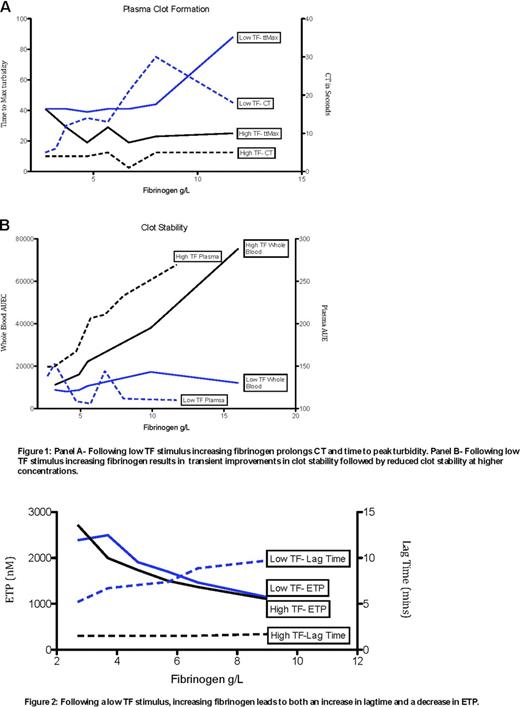Abstract
Abstract 384
A Procoagulant and an Anticoagulant
Introduction: Bleeding occurs secondary to acquired fibrinogen deficiency but the effect of high fibrinogen is more controversial. Correlation between raised fibrinogen levels and venous or arterial thrombosis has been recorded. However, fibrinogen increases as an acute phase response and may be an innocent biomarker, detected at elevated levels in individuals with concomitant disease. Recent animal studies provide evidence that high fibrinogen does not trigger thrombosis per se, but enhances thrombotic occlusion of vessels following tissue injury. Aims: This study aims to investigate the effect of elevated levels of fibrinogen on thrombin generation and clot resistance to accelerated fibrinolysis. We hypothesised that fibrinogen promotes clot stability following a high tissue factor stimulus (TF), but will act as an anticoagulant following low TF stimulus. Method: Normal human plasma was spiked with fibrinogen to achieve final plasma concentrations of 2.7, 3.2, 3.7, 4.7, 5.7, 6.7, 8 and 11.7g/l. Coagulation was initiated with TF at variable dilutions (1:20000, 1: 500) plus calcium. To assess clot stability the same assay was performed with simultaneous addition of tissue plasminogen activator (t-Pa 0.75nmolar). Clot formation and lysis was recorded via light absorbance (FLUOstar Omega). Clot stability was also measured by whole blood thromboelastometry; citrate and CTI stabilized whole blood was drawn from a healthy individual and spiked with fibrinogen (calculated plasma concentrations: 3.2, 4, 3.9, 5.5, 9.9, 16 g/l). Coagulation was triggered with TF (1: 50000 or 1:500), calcium and of t-Pa (2nmolar). The area under elasticity curve (AUEC) at 90mins was the primary endpoint. Thrombin generation in plasma was performed in plasma following addition of fibrinogen using fluorogenic substrate and calcium (FluCä, Thrombinoscope BV, The Netherlands). Results:Plasma clot formation assay: Dose dependent shortening of clot time and time to peak turbidity were seen with increasing fibrinogen following a high TF stimulus (TF 1:500) (figure 1- panel A). Conversely, following a low TF stimulus increasing fibrinogen caused a lengthening of the clotting time. Plasma and whole blood lysis assays: With high TF stimulus, fibrinogen produced a dose-dependent increase in clot stability measures (AUC/AUEC) in both plasma and whole blood assays (figure 1-panel B). Following a low TF stimulus increases in the fibrinogen concentration resulted in suppressed clot stability. Thrombin generation: A decrease in total thrombin generation was seen with increasing fibrinogen (Figure 2) at both high and low TF levels. With high TF there was no alteration in lag-time, but with low TF stimulus the lag-time progressively lengthened as fibrinogen concentration increased. Discussion: Fibrinogen acts as a pro-coagulant by promoting clot formation and supports clot stability following a high TF stimulus. However, following a low TF stimulus elevated fibrinogen becomes an anticoagulant as demonstrated by prolonging clotting time and decreases clot stability in both plasma and whole blood. In conclusion, our data suggest that elevated fibrinogen per se is not thrombogenic. However, following a significant trauma resulting in a high tissue factor stimulus and high thrombin generation, fibrinogen acts predominantly as a pro-coagulant enhancing clot formation and supporting clot stability. This may protect against bleeding or contribute to pathological thrombotic events. In contrast, following a minor trauma prompting a minimal tissue factor stimulus, fibrinogen predominantly acts as an anticoagulant and may protect against thrombosis.
No relevant conflicts of interest to declare.
Author notes
Asterisk with author names denotes non-ASH members.


This feature is available to Subscribers Only
Sign In or Create an Account Close Modal